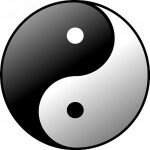The yin yang of sustainability
Throughout sustainability circles one word is a constant: change. Sustainability is ultimately about instigating, managing and navigating change.
Or so it seems.
Look more closely, however, and the picture appears incomplete. Aren’t we forgetting the yang to the yin of change? It’s worth asking, because many of those we hope to influence value stability far more than change.
This yin yang of sustainability came to mind after watching a provocative video presentation by psychologist Jonathan Haidt about the moral roots of liberals and conservatives. His comments were made within the context of politics. I found them equally relevant to my work as a consultant in sustainable branding, where the role of values is crucial.
politics. I found them equally relevant to my work as a consultant in sustainable branding, where the role of values is crucial.
Liberals and conservatives
Haidt’s research finds that liberals in societies throughout the world share a common attribute of “openness to experience.” They value novelty, diversity, cross-cultural experiences. They’re comfortable with change. I would say some even insist on it.
Conservatives, on the other hand, value attributes such as safety and dependability. They seek order and stability.
“The great conservative insight,” Haidt told his mostly liberal audience, “is that order is really hard to achieve. It’s really precious, and it’s really easy to lose.”
Haidt was referring to civilized societies. He could just as easily have been speaking of business. The bursting economic bubbles and normal ups and downs of daily business make periods of stability precious indeed. As a businessperson, I love stability — and I’m a liberal.
I don’t know anyone who enjoys making decisions in the midst of chaos or disorder. That may be why businesses tend to be conservative organizations. They seek stability so they can reduce the risk of making poor, hurried decisions and increase the likelihood of success.
Resisting change vs. desiring stability
We’ve long been told humans resist change because we fear the unknown. Dealing with and overcoming resistance to change is how we often frame our most pressing business challenges. We all know the frustrations of executives trying to move their employees in new directions or “change agent” employees trying to persuade their reluctant bosses.
One person’s resistance to change, however, is another person’s desire for stability. There’s a difference. Seeking stability doesn’t automatically mean resisting change. Consider, Haidt says, the gods Vishnu the preserver and Shiva the destroyer, two of the three gods in the Hindu trinity (along with Brahma the creator). The worship of stability (Vishnu) and change (Shiva) are foundational in one of the world’s great religions.
In other words, change and stability, far from being enemies, need each other to create a world that’s whole. Or a business in balance.
The liberal narrative
I’d like to think sustainability is an apolitical issue. Still, Haidt’s liberal-conservative characterization helps explain why liberals dominate sustainability gatherings. We love talking about changing the world. It excites us. Gives us purpose. We’re driven to undo all the damage humans and institutions have done to each other and the environment. And we believe our arguments for change are unassailable: How can anyone ignore global warming, decimated ecological systems, the rich-poor divide? Things have to change.
That’s our narrative. And we’ve had some success in spreading its message. More and more businesses are awakening to their social and environmental responsibilities. If Walmart, of all companies, can enjoy acclaim among environmentalists for its sustainability leadership, positive change must indeed be occurring.
Still, the case for sustainability remains a murky work in progress. The disappointing Copenhagen talks proved how divided our world leaders remain on the actions and timetables needed to prevent the worst of climate change (there’s that word again). And despite some high-profile exceptions, business leaders have been slow to see the light of sustainability.
A balanced approach
We’ll reach and influence more people by attending to both sides of the sustainability equation: change and stability. When making the case for sustainability, especially in the realm of business, try speaking less to the need for change and more to the benefits of stability and order.
Demonstrate to executives how the adoption of sustainable business practices lessens the likelihood of disruptive change by creating more resilient organizations. Prove to employees that sustainable practices create a more secure work place. And show customers how your products and services respect their innate desire for reliability and dependability — while doing no harm.
Yes, achieving sustainability requires change. And it produces stability. We’d do well to remember both.
Special thanks to friend Thomas Joseph Doherty for pointing me to Haidt’s video.


The bottom line is balance.
From chaos comes order. From order comes stagnation.
Sustainability and balance are synonymous – not measured as right or wrong, left or right, profit or loss, but as a necessary and continuous ebb and flow.
Opposites only describe temporary poles, not permanent positions. Everything is in motion. Everything is subject to change – imbalance and balance again. Sustainability.
Comment by Chas Martin — January 6, 2010 @ 5:20 pm